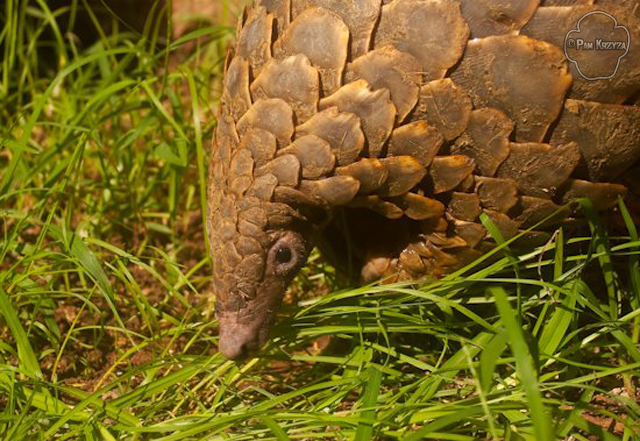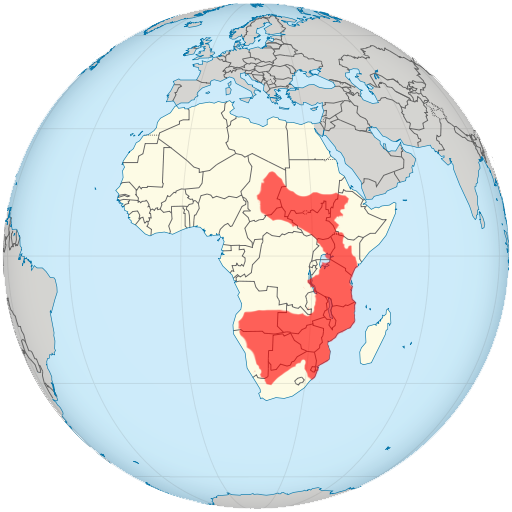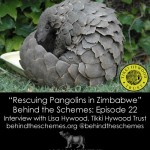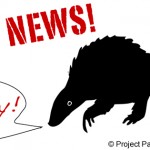Cape pangolins ROCK!

The Cape Pangolin (Smutsia temminckii) is one of the larger and more terrestrial of Africa’s four pangolin species.
Adults of this variety can reach full body lengths (i.e from head to tail) of 65-111 centimeters and can weigh between seven and eighteen kilograms.
Tending to stay relatively close to a water source, they are found in a variety of woodland and savanna habitats (frequently with thick undergrowth), as well as in floodplain grasslands and even in farm lands.
Their range is said to be restricted by the abundance of their ant and termite prey, particularly of a few specific species.
An interesting fact about this fascinating creature: When not using its tongue to lap up the delicious insects, the tongue retracts into a pouch located in its throat!
Like other scaly anteaters, Cape pangolins (also called the Temminck’s Ground Pangolin, or just ‘ground pangolin’) are mainly nocturnal creatures, staying holed up in underground dens during the day.
Although they are capable of excavating their own burrows, this species generally uses those previously dug out by other animals, such as aardvarks, aardwolves, and spring hares.
Cape pangolin mating season occurs through the southern hemisphere’s late summer to early autumn and after a pregnancy lasting around 140 days, the females give birth to only a single young per year, in the winter.
In South Africa and Malawi, they are considered quite rare and threatened — mainly because of overhunting.
They are targeted for their flesh, scales, skin, and other body parts, which are eaten or may otherwise be consumed in “muti” or other folk medicines, or in cultural rituals and practices.
In parts of east Africa, they are known as “Bwana Mganga” (which roughly translates to “Mr. Doctor”), as some people believe all of their body parts hold healing properties.
Seeing this pangolin is considered a good omen in parts of Zimbabwe, where it is unfortunately a tradition to catch them and present them to elders or other respected members of society as a gift for their consumption.
- IUCN Conservation Status: Least Concern (since 2008)
- Protection: Present in many protected areas and protected from international trade under CITES Appendix II
- Range: Eastern and southern Africa, including Angola, Botswana, Central African Republic, Chad, Ethiopia, Kenya, Malawi, Mozambique, Namibia, South Africa, Sudan, Swaziland, Tanzania, Uganda, Zambia, and Zimbabwe. Its presence is uncertain in Congo and Rwanda.
Although there are no estimates for its total population size, the Cape pangolin is not currently considered a species of significant concern for conservation, as it is thought to be widespread, locally abundant, and present in numerous protected areas.
Be that as it may, the species is in decline and is fairly heavily hunted in some places, which has led to concerning reductions of some local populations (such as in the aforementioned areas of southern Africa).
They are also threatened to a much lesser degree by pesticide poisoning, brushfires, and electric fences used at many farms and private game reserves.
Cape pangolins are protected by legislation in a few of their range states (such as in Botswana, for example), but conflict over indigenous peoples’ rights for traditional use of these animals often trumps existing legislation.
More research on this animal is certainly needed and there is a pressing need to develop and enforce protective legislation throughout its range, in order to ensure a secure future for this species.
Sources:
“Smutsia temminckii,” International Union for the Conservation of Nature Red List of Threatened Species, accessed 28 January, 2012
“Ground pangolin (Smutsia temmickii),” Arkive, accessed 28 January, 2012
Image #1 ©Pam Krzyza
Image #2 via Wikimedia Commons, with range added by author



![Baby Pangolin Sticks Out His Tongue [Video]](https://www.pangolins.org/wp-content/uploads/2012/02/BabyCapePangolinTongue-150x150.jpg)

![Kruger National Park Visitors Enjoy Pangolin Sighting [Video]](https://www.pangolins.org/wp-content/uploads/2012/09/cape-pangolin-from-youtube-video-150x150.jpg)

1 Comment
Comments are closed.